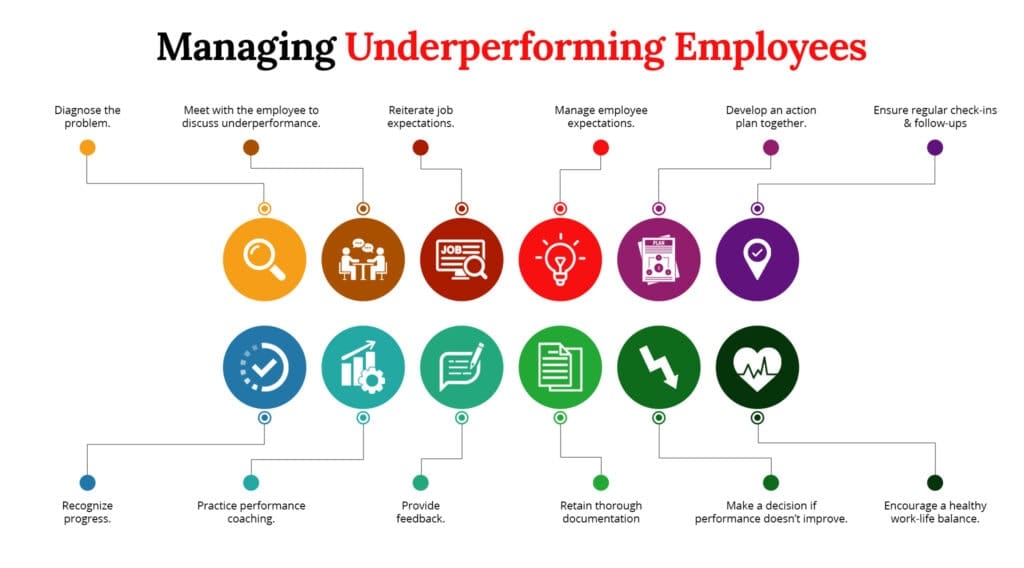If you have an employee who is not meeting your expectations, it can be difficult to know what to do. In this blog post, we will discuss tips and strategies for managing an underperforming employee. We will cover how to diagnose the problem, how to set expectations, and how to provide feedback. By following these tips, you can help your underperforming employee get back on track!
Diagnosing an Underperforming Employee
When you have an underperforming employee, the first step is to diagnose why the employee is underperforming.
There could be many reasons why an employee is underperforming, including lack of motivation, interpersonal issues, health-related issues, personal circumstances, lack of communication, and much more.
Take a step back and look at the big picture. Has this employee always been underperforming, or is this a recent development? Are there any changes in the workplace that may be contributing to the problem? Is something distracting them at work? Once you have a clear understanding of the situation, you can begin to identify potential causes.
Talk to the employee in question. Ask them how they are feeling and if there is anything going on that might be impacting their work. It is important to create an open and safe environment where employees feel comfortable sharing concerns.
Consider whether the issue is with the employee or with the job itself. Does the employee have the skills and knowledge necessary to be successful in their role? Is the workload reasonable, or are they being asked to do too much? If it appears that the problem lies with the job itself, make adjustments to help the employee be more successful. However, if the problem continues due to other reasons that are not personal, it is time to be honest with your employee.

Be Honest
As a manager, it’s important to be honest with your employees about their performance. If there are issues that need to be addressed, it’s important to be clear and direct with your employees as soon as possible. Hinting at improvements or being vague about the severity of the issue can only lead to confusion and frustration on the part of the employee. Instead, commit to honesty and be clear about what needs to be done in order to improve.
Work environment transparency is a large part of keeping employees happy. If something isn’t going right, your employees know that they can bring it up without repercussions and feel confident in their leadership. The same should go for you.
Your employees will appreciate your directness rather than having to decode your subtle hints.
In the end, being honest with your employees from the beginning will help to improve their performance and contribute to a better work environment for everyone.
Check-In Regularly
As any manager knows, it can be difficult to deal with underperforming employees. Not only is it frustrating to see someone not meeting their potential, but it can also be challenging to figure out how to help them improve.
One way to address the issue is to create a plan for regular check-ins. This way, you can keep track of their progress and identify any areas where they may be slipping. The key is to tailor the plan to each individual employee. Creating a plan for each individual employee will help you focus on their strengths and help them make the necessary corrections. By taking this proactive approach, you can ensure that your employees are performing at their best.
Set Goals
Part of your job is to set clear expectations for your team members. This is especially important when it comes to employees who are struggling to meet the standards you have set. Without clear performance metrics, it can be difficult for an employee to identify areas where they need to improve. Furthermore, vague or incomplete performance goals can make it hard for an employee to know what they should be working towards.
To ensure that your team members have the structure they need to succeed, be sure to break down long-term goals into achievable tasks. By doing so, you will give your employees the guidance they need to make the necessary improvements.

Make Hard Choices
When it comes to workplace productivity, a performance plan is often seen as the first line of defense. And in many cases, a well-crafted performance plan can be enough to get an employee back on track. But there are times when a performance plan alone won’t be enough to improve an employee’s commitment to exemplary work.
If your employee isn’t performing at a more satisfactory level, you’ll need to make the difficult decision to let them go. Don’t take too long to find a replacement or your team may feel like they’re being punished for someone else’s poor behavior. You can always bring in extra help while you begin the hiring process. Making the decision to let an employee go is never easy. But in some cases, it’s necessary in order to maintain a high level of productivity in your workplace and to improve office wellbeing.
Managing an Underperforming Employee
As a manager, it can be difficult to deal with an employee who is not meeting your expectations. You may feel like you are constantly giving feedback and setting goals, but the employee is still not meeting your standards. Before you can address the problem, you need to diagnose the cause. There are several reasons why an employee might be underperforming, including lack of motivation, skill set, or experience.
Once you have identified the cause, you can set expectations and provide feedback. For example, if the employee is lacking motivation, you can provide encouragement and praise when they reach milestones. If they lack experience, you can give them more challenging tasks or assignments.
By following these tips, you can help your underperforming employee get back on track!






